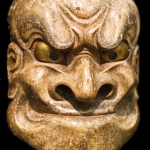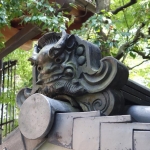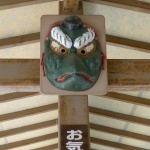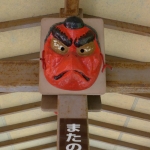Demons
winter drizzle –
at the temple I borrow an old umbrella
looking like a ghost
–Buson
Oni are variously translated as demons, devils, ogres, or trolls. They are popular characters in Japanese art, literature and theatre.
Depictions of oni vary widely but usually portray them as hideous, gigantic ogre-like creatures with sharp claws, wild hair, and two long horns growing from their heads. They are humanoid for the most part, but occasionally, they are shown with unnatural features such as odd numbers of eyes or extra fingers and toes. Their skin may be any number of colors, but red and blue are particularly common.
They are often depicted wearing tiger-skin loincloths and carrying iron clubs called kanabō. This image leads to the expression “oni with an iron club,” that is, to be invincible. It can also be used in the sense of “strong beyond strong”, or having one’s natural quality enhanced or supplemented by the use of some tool. In addition to this, it can mean to go overboard, or be unnecessarily strong or powerful.
The word “oni” is sometimes speculated to be derived from on, the on’yomi reading of a character (隠) meaning to hide or conceal, as oni were originally invisible spirits or gods which caused disasters, disease, and other unpleasant things. These nebulous beings could also take on a variety of forms to deceive (and often devour) humans.
The invisible oni eventually became anthropomorphized and took on its modern, ogre-like form, partly via syncretism with creatures imported by Buddhism, such as the Indian rakshasa and yaksha, the hungry ghosts called gaki, and the devilish underlings of Enma-Ō who punish sinners in Jigoku (Hell).They share many similarities with the Arabian Jinn.
Another source for the oni’s image is a concept from China and Onmyōdō. The northeast direction was once termed the kimon (鬼門, “demon gate”), and was considered an unlucky direction through which evil spirits passed. Based on the assignment of the twelve zodiac animals to the cardinal directions, the kimon was also known as the ushitora (丑寅), or “Ox Tiger” direction, and the oni’s bovine horns and cat-like fangs, claws, and tiger-skin loincloth developed as a visual depiction of this term.
Temples are often built facing that direction, and Japanese buildings sometimes have L-shaped indentions at the northeast to ward oni away. Enryakuji, on Mount Hiei northeast of the center of Kyoto, and Kaneiji, in that direction from Edo Castle, are examples. The Japanese capital itself moved northeast from Nagaoka to Kyoto in the 8th century.






